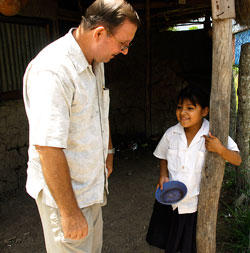 There is a group of indigenous people in Honduras that live off an average of $300 a year… less than one dollar a day. At least two months out of every year they starve. That’s the reality as Billy Collins sees it. Billy has been working with the Chortí Maya, the direct descendants of the Mayan Indians, for five years.
There is a group of indigenous people in Honduras that live off an average of $300 a year… less than one dollar a day. At least two months out of every year they starve. That’s the reality as Billy Collins sees it. Billy has been working with the Chortí Maya, the direct descendants of the Mayan Indians, for five years.
I met Billy in Copán Ruinas, a charming town in Western Honduras not far from the Guatemalan border. The small, cobblestoned town is “base camp” so-to-speak for visiting Honduras’ famous ancient Mayan ruins. That’s why I am here: to see the ruins. But, it’s been three days and I have yet to explore them. Instead, I’ve been exploring the harsh realities of the Chortí Maya, realties that Billy, his wife Mary and a handful of others are committed to changing. And, they’re making those changes largely through agriculture. I spent an entire day with Billy touring villages of adobe huts with straw roofs, bumping and bouncing along dirt roads consistently washed out by the wet season’s frequent rains to get to them.
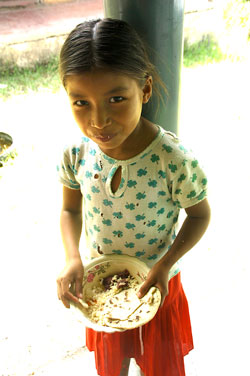 While Billy and his wife are involved in more than a handful of projects with the Chortí, their SALT project, or Sloping Agricultural Land Technology, is among one of the biggest. It’s a project that’s aimed at training the indigenous people how to cultivate their rolling, mountainous lands more efficiently and successfully. Through a double hedgerow terracing technique, Billy says the Chortí Maya can double, even triple their current crop yields.
While Billy and his wife are involved in more than a handful of projects with the Chortí, their SALT project, or Sloping Agricultural Land Technology, is among one of the biggest. It’s a project that’s aimed at training the indigenous people how to cultivate their rolling, mountainous lands more efficiently and successfully. Through a double hedgerow terracing technique, Billy says the Chortí Maya can double, even triple their current crop yields.
“We give them enough to plant like a half acre, enough seeds,” Billy said. “I’m talking about seeds for their terracing. We use leguminous seeds to terrace. We use the A-frame to mark out how terraces should go and then they plant it… We want to stop water long enough to let it drop the soil, let plants get taller, this soil will get higher and they’ll have good soil. In three to four years, if they do this right they can double their harvest.”
The key, Billy is quick to point out, is the villagers’ hands-on role in the training.
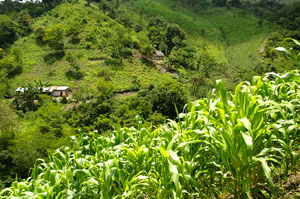 “We go out in the village and we ask for [local] volunteers who want to enter the program,” Billy said. “We teach them how to use the A-frame. We teach them how to space out their seeds. Then, they have to go home and prepare their own land, about a half acre. Then, we will come and look at it and if it’s done then we will give them the seeds to plant… They just take a stick and they just punch a hole in the ground. They drop one seed of corn in there, cover it. And then they know how far to step. And then they put another hole in the ground. They put in two kernels of corn. Cover it. And then all this was planted by hand like that. Then they go back beside it on the uphill side, about four inches from it, when it’s time to fertilize, and they’ll punch a hole and they’ll put three fingers worth of fertilizer in the hole. But all of it’s done by hand. Every bit of it.”
“We go out in the village and we ask for [local] volunteers who want to enter the program,” Billy said. “We teach them how to use the A-frame. We teach them how to space out their seeds. Then, they have to go home and prepare their own land, about a half acre. Then, we will come and look at it and if it’s done then we will give them the seeds to plant… They just take a stick and they just punch a hole in the ground. They drop one seed of corn in there, cover it. And then they know how far to step. And then they put another hole in the ground. They put in two kernels of corn. Cover it. And then all this was planted by hand like that. Then they go back beside it on the uphill side, about four inches from it, when it’s time to fertilize, and they’ll punch a hole and they’ll put three fingers worth of fertilizer in the hole. But all of it’s done by hand. Every bit of it.”
Most of the seeds the Chortí are planting are corn and beans.
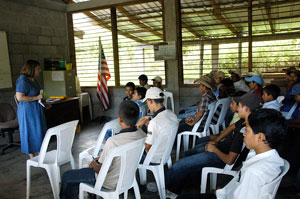 “Right now the Chorti live on tortillas and beans and that’s basically it,” Billy said. “And a few fruits. We’re basically trying to expand their diet… We give them ten fruit trees of their choice, like different type of orange trees, lemons whatever they want. Then, if they do well with this program and keep their hedgerows up, in between the hedge rows they plant beans, corn, and a permanent crop like coffee. Then there will be another double hedgerow on up to the top of the hill. On the top of the hill we try to get them to plant the trees.”
“Right now the Chorti live on tortillas and beans and that’s basically it,” Billy said. “And a few fruits. We’re basically trying to expand their diet… We give them ten fruit trees of their choice, like different type of orange trees, lemons whatever they want. Then, if they do well with this program and keep their hedgerows up, in between the hedge rows they plant beans, corn, and a permanent crop like coffee. Then there will be another double hedgerow on up to the top of the hill. On the top of the hill we try to get them to plant the trees.”
Billy stresses that his project is not a welfare program.
“We know that welfare does not work in the United States,” Billy said. “There is no end to trying to feed people. Here in Honduras, with a little education, they can feed themselves.”
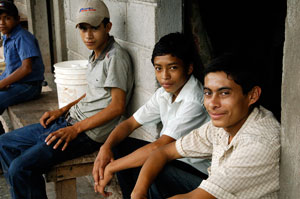 Bottom line: Billy says his program will not plant crops for the people, but instead will train them how to plant it themselves. It’s an aid policy that Billy says is more sustainable and more valuable for these people in need.
Bottom line: Billy says his program will not plant crops for the people, but instead will train them how to plant it themselves. It’s an aid policy that Billy says is more sustainable and more valuable for these people in need.
The training begins at a six-acre farm (3.5 manzanas) developed by Billy, his wife, other project leaders and the locals. The land was originally communal property that belonged to the Chortí Council. The council gave the project permission to use the land for five years. However, in order to avoid trouble in the future should the leadership of the Chortí Council change hands and the land agreement expires, the Chortí people have decided to legally designate the land as an agricultural training center. The center is where the local villagers come for about three full days of training in SALT techniques. Billy says, that’s all the time it takes to start drastically changing the lives of the Chortí people. Billy says the project is currently working with 100 Chortí families.
 Without the training though, Billy says the villagers’ situation is desperate. Traditional farming practices of the more than 50 Chortí Maya villages are leading to rampant deforestation.
Without the training though, Billy says the villagers’ situation is desperate. Traditional farming practices of the more than 50 Chortí Maya villages are leading to rampant deforestation.
“All their soil just washes away and in a few years and they make very little corn and they have very little to eat,” Billy says. “So they’ve got to learn to save and protect what they have because they’re not going to get anymore. The government’s not going to buy anymore land for them.”
Right now, the government gives each family just under an acre of land to farm, and that’s about all most will ever get. The land, relatively near the ancient Mayan ruins in a stunning terrain of peaks and valleys that are canvassed in mountainous jungle, is valued at up to $1200 per acre. That’s a price that’s ridiculously unfordable for a people whose income averages less than a dollar a day. But, Billy’s project is tackling the deforestation issue in more ways than one. Aside from training the villagers in SALT and teaching them how to sustain terraced, nitrogen-rich soil, the project also offers them the chance to cultivate self-propagating indigo trees from Indonesia as a renewable source for firewood. Billy says the goal is to give each family 365 indigo trees.
“This tree is self-propagating so after a year, the wife could go out and cut the tree down, have a days worth of firewood and that tree would start growing [again],” Billy said. “She would just continually have a supply of firewood around the house and they wouldn’t have to go around and cut all the forest down because 95 percent of the people in Honduras burn firewood to cook with.”
Crops and firewood isn’t the only agricultural help the project offers the Chortí. Billy says they also help the villagers develop proper pens for housing goats.
“We’ll give them a goat, three goats,” Billy said. “Three female goats pregnant at different times… I will give them the roof, the metal for the roof [of the goat house] and I will loan them enough money to build a house. The goat house is 8 feet by ten feet, and it’s built up off the ground. It has a half inch space. The floor’s done in slats or strips and there’s a half inch space between each strip and that way the manure falls through. Every three days, they rake this up because it’s built up off the ground. They can use that for fertilizer. The goats never touch the ground.”
Though Billy does offer some free aid and materials initially, he says program is designed to teach the villagers to pay back part of their aid.
“We give them enough seeds that they’ll plant a forage area. And they carry water and they’ll feed em twice a day. And when they have a baby, the first weaned female comes back to me so I can give it to another family,” Billy said. “Remember I gave them three goats. Then, the others, I will give them 400 Lempiras which is a little over $20 dollars for each good female and that way they can pay back for their goat house. We want all males castrated within 30 days and then they can fatten that up to eat it or they can sell it to make.”
The goats, Billy says, also help offer young Chortí children another milk source for vital nutrients.
“The children here, after they reach the age of two, they do not receive anymore milk because the mother weans them at the age of two and then she’s going to have another kid,” Billy said.
Billy says the project also offers similar programs with cattle, bees and honey, and vegetables if the villagers show they’re making progress and are paying off their debts. All the loans that Billy offers are free of interest.
For Billy and Mary, it’s all about education.
“There’s no reason they should go hungry,” Billy says. “No reason… They really need to be taught.
And they’re willing to learn. There are more that want to learn than don’t.”
The agricultural project is a big one, but it’s just one of many. Some other projects the couple is involved with include housing, clean water and health education and aid for the Chortí people. Billy says many of the projects they’re involved in are funded and supplemented by help and donations from various aid organizations, such as religious groups, non-governmental organizaitons and medical groups as well as private donations. One of the greatest needs that Billy describes right now is more aid in reforestation expertise.
You can contact Billy and Mary directly at billyccollins@gmail.com.
Here’s a video of a tour through a Chortí adobe hut. I also have video of the Chortí Maya Agricultural Center, but it’s been a menace to upload…
